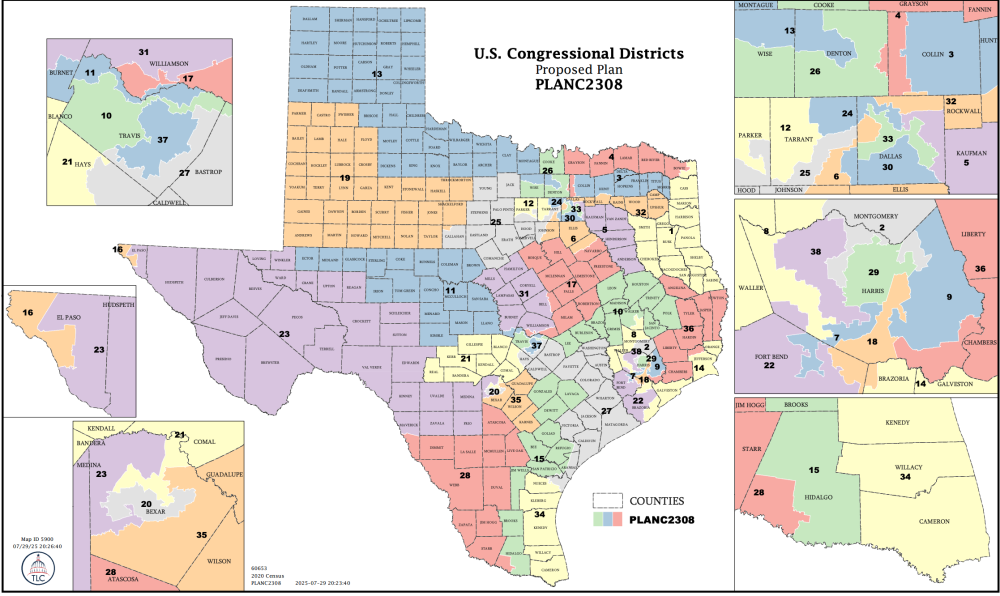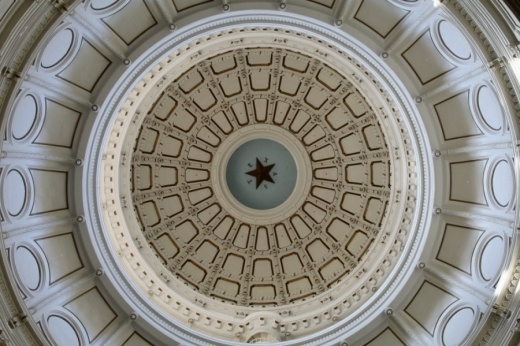On July 15, President Donald Trump told reporters outside the White House that he wanted Texas to net five new U.S. House seats for Republicans, noting that “there could be some other states where we’re going to get three or four or five [seats].”
Republicans currently hold 25 of Texas’ 38 congressional districts—and they could hold up to 30 after the 2026 midterms, according to a social media post by David Wasserman, an elections analyst for the nonpartisan Cook Political Report.
The proposed map could change amid negotiations with the Texas Senate.
The Texas House redistricting committee will discuss the map and hear public testimony during an Aug. 1 committee hearing, which is scheduled to begin at 10 a.m. State lawmakers have until Aug. 19, the final day of the current special legislative session, to send a new congressional map to Gov. Greg Abbott’s desk.

According to information from the nonpartisan Texas Legislative Council and political analysts, the proposed map would make the following changes:
- Houston: combine Texas’ 9th Congressional District, held by U.S. Rep. Al Green, D-Houston, with the vacant 18th Congressional District and create a new 9th District
- Dallas-Fort Worth: merge the 32nd and 33rd Congressional Districts—held by U.S. Reps. Julie Johnson, D-Farmers Branch, and Marc Veasey, D-Fort Worth—to create a new 32nd District
- Austin-San Antonio: combine the 35th and 37th districts, held by Austin Democratic Reps. Greg Casar and Lloyd Doggett, and create a new 35th District
- South Texas: redraw Rep. Henry Cuellar’s 28th District and Rep. Vicente Gonzalez’s 34th District
Casar called the proposed map “illegal voter suppression of Black and Latino Central Texans.”
“If Trump is allowed to rip the Voting Rights Act to shreds here in Central Texas, his ploy will spread like wildfire across the country,” Casar said in a July 30 statement. “Everyone who cares about our democracy must mobilize against this illegal map.”
During a July 24 House hearing, before a proposed map had been released, House redistricting committee chair Rep. Cody Vasut, D-Angleton, said that while lawmakers did not request that Texas’ congressional maps be redrawn, it was important to hear from Texans about the potential impacts of redistricting.
“We are here today to hear from the public about what that revision should be, if any,” Vasut told House committee members July 24. “We're going to follow the Voting Rights Act, we're going to follow the law, and we have no plans to change any particular district.”
Senate redistricting committee chair Sen. Phil King, R-Weatherford, told senators during a brief meeting July 30 that he did not know if he or other senators would file separate congressional maps, adding that he was “certainly not going to make a decision until I see how things are moving in the House.”
King said the House proposal made “a lot of adjustments in a lot of districts.”
“I have no idea what the legal implications are, if it meets the [Voting Rights Act] and other requirements,” King said. “I suspect it does, but I want to check that. I’m just going to have to spend a lot of time, as everybody else will, trying to decide if it’s good policy the way the maps are drawn.”Zooming in
The proposed congressional map would create one new district where Hispanic residents make up a majority of eligible voters, and two new majority-Black districts, according to TLC data.
“The most remarkable feature of [the map] is that it manages to add Republican strength while at the same time increasing minority representation,” Matthew Wilson, a political science professor at Southern Methodist University, said July 30.
Some Hispanic Texans have leaned more Republican in recent elections, Wilson told Community Impact.
“You couldn't have simultaneously done those things with the Latino voting patterns of 10 years ago, but the fact that they moved towards the Republican Party, especially in South Texas, gave the Republicans more flexibility,” he said.
Wilson said the proposed map could pit Democratic incumbents against each other in Austin and Dallas. Casar and Doggett’s Austin-area districts would be combined under the plan, with a new 35th Congressional District covering south Bexar County and Guadalupe, Wilson and Karnes counties. This means the two Democrats could face off in a primary election for the newly drawn 37th District in Austin if neither steps down.
Dallas-area Democrats Johnson and Veasey could also face each other in a 2026 primary.
“Johnson's district gets essentially totally cannibalized by this plan and turned into a Republican-leaning district, whereas Veasey’s becomes Dallas-centered, and [Johnson] might choose to run against him,” Wilson told Community Impact.
Under the U.S. Constitution, U.S. House lawmakers must live in the state they represent, although they do not have to reside in the specific district they serve.
Also of note
Texas Democrats have floated leaving the state—known as a quorum break—to stop or draw out the redistricting process. A two-thirds majority, or quorum, is needed to conduct business in each legislative chamber, meaning at least 100 House members and 20 senators must be present to vote on motions and pass legislation in their respective chambers.
“With my colleagues, I am prepared to break quorum when the time is right,” state Rep. Gina Hinojosa, D-Austin, told about 100 people at a rally ahead of a July 24 redistricting hearing.
Wilson said it would be “very difficult” for Democrats to stop the redistricting effort altogether, noting that Abbott “can just keep calling special session after special session [for] as long as it takes.”





